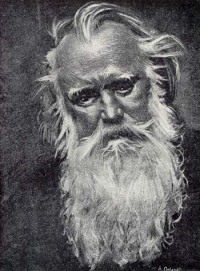Good Friday, April 10, 1868

Starting from an unused funeral march he’d written years before, Brahms began his requiem after the death of his mother in 1865, an event that added timely weight to his longstanding desire to memorialize his friend and mentor Robert Schumann. It all tied together, at least for writers, when Brahms bumped into Clara Schumann (widow to Robert and friend to Brahms’s mother — and around when Brahms had thought up the funeral march while trying to write piano music) outside the Bremen cathedral on the way into that first performance.
Written on a personal impetus during the romantic period (virtually defined by the concept of personal narrative), the Requiem is not liturgical. Its full title translates as “A German Requiem, after words of the Holy Scriptures.” There are only two soloists: a soprano singing of consolation on behalf of Brahms’s mother, and a baritone whose “Behold, I tell you a mystery” solo anchors a movement so searching, emotional and yet historically learned that it simply must be a musical conversation with Schumann.
If you listen to a classical station regularly, chances are you already know that 141 years ago on another April 10, Good Friday, the first performance of the Brahms requiem took place in Bremen.

Starting from an unused funeral march he’d written years before, Brahms began his requiem after the death of his mother in 1865, an event that added timely weight to his longstanding desire to memorialize his friend and mentor Robert Schumann. It all tied together, at least for writers, when Brahms bumped into Clara Schumann (widow to Robert and friend to Brahms’s mother — and around when Brahms had thought up the funeral march while trying to write piano music) outside the Bremen cathedral on the way into that first performance.
Written on a personal impetus during the romantic period (virtually defined by the concept of personal narrative), the Requiem is not liturgical. Its full title translates as “A German Requiem, after words of the Holy Scriptures.” There are only two soloists: a soprano singing of consolation on behalf of Brahms’s mother, and a baritone whose “Behold, I tell you a mystery” solo anchors a movement so searching, emotional and yet historically learned that it simply must be a musical conversation with Schumann.
For YouTube junkies, how about this complete performance, gathered in a convenient playlist? It features Claudio Abbado conducting the Berlin Philharmonic with the Swedish Radio Chorus and Eric Ericson Chamber Choir, with Bryn Terfel and Barbara Bonney. And subtitles?
See the entire playlist or watch the opening:
There’s another complete performance on YouTube by Otto Klemperer. The Wikipedia entry for Ein Deutsches Requiem has all the texts in German and English.